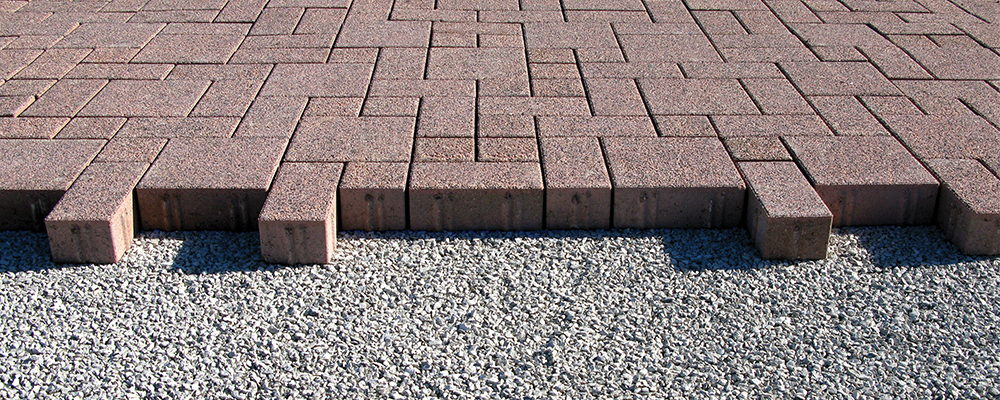Permeable pavers are rapidly gaining popularity as a tool for managing stormwater runoff. Permeable paving systems offer numerous benefits, including improved water quality, reduced erosion, and enhanced aesthetics. However, not all permeable paver installations are created equal. To ensure that your permeable pavement project is successful, it’s important to understand the nine key components that make up a high-quality permeable paving system.

1. Unilock Permeable Interlocking Concrete Paver
With many aesthetically pleasing colors and textures, creative choices are not compromised by function. Permeable Interlocking Concrete Pavers (PICPs) are the most durable of any porous pavement material. Unilock minimum 8,500 psi (57 MPa), high-strength, no-slump concrete allows water to infiltrate between paver units instead of through the material. The joint sizes vary between paver options, ranging from 0.25″ (6 mm) to 0.5″ (13 mm), which meet the Americans with Disabilities Act recommendation for joints or openings, and allows a minimum of 100″ (2,540 mm) per hour of surface infiltration.
2. Joint Aggregate – ASTM No. 8 OR 9
As the initial filtering layer, the 0.25″ (6 mm) crushed, angular, chip stone captures approximately 80 percent of debris in the first 1″ (25 mm) to 2″ (51 mm). The secondary function of the joint aggregate is to increase the positive interlock between the paver units, which is essential to the structural stability of the PICPs. The joint aggregate must always remain filled to the lip of the PICP units to reduce unnecessary clogging.
3. Setting Bed Aggregate – ASTM No. 8
Using the 0.25″ (6 mm) crushed, angular, chip stone, instead of sand, provides a smooth leveling course for placing pavers and additional structural interlocking of the PICPs. Unlike sand, the setting bed aggregate allows for rapid water infiltration with over 500″ (12,700 mm) per hour through the 40 percent void-space. Sand must be avoided as a setting bed in a PICP application.
4. Base Aggregate – ASTM No. 57
When subsoil conditions are conducive to supporting the ASTM No. 57 (12.5-25mm) crushed, angular, open-graded base material without migration, it can be used without ASTM No. 2 (50-63mm) subbase aggregate. Minimum thickness must be designed to sufficiently support anticipated loads, as well as accommodate stormwater detention in the 40 percent void space of the material. The ASTM No. 57 base aggregate, with a minimum thickness of 4″ (102 mm), serves as a transition material between the ASTM No. 8 (2-10mm) setting bed and the ASTM No. 2 subbase aggregate. The infiltration rate of the ASTM No. 57 is over 500″ (12,700 mm) per hour.
5. Subbase Aggregate – ASTM No. 2
Subsoil conditions will dictate the necessity of this larger ASTM No. 2 (50-63mm), crushed, angular, open-graded subbase aggregate thickness. Installation of such material will provide increased structural stability on sites with poor soil conditions. A minimum thickness of 8″ (203 mm) is required for effective performance. Subbase aggregate thickness must be designed to sufficiently support anticipated loads. As an added feature, the ASTM No. 2 subbase aggregate temporarily detains stormwater runoff in the 40 percent void-space of the material. The ASTM No. 2 also has an infiltration rate of over 500″ (12,700 mm) per hour.
6. Subgrade
Existing soil materials will determine the performance capabilities of the PICP system. Pre-construction soil analysis, including percolation, California Bearing Ratio and penetrometer measurements (blow counts), are mandatory for proper design. Subsoils with less than 0.5″ (13 mm) per hour of infiltration may require underdrainage, scarification and potentially amendments. Subsoils with greater than 0.5″ (13 mm) per hour are considered highly permeable. Subsoil compaction can cause a detrimental reduction in permeability and can be eliminated.
7. Edge Restraint
PICP containment is vitally important to the success of interlocking properties. Lack or failure of an edge restraint will negatively impact the integrity of the pavement surface. For all vehicular PICP applications, an edge restraint, such as a concrete curb, is required. For non-vehicular and pedestrian areas, a plastic edging is sufficient when properly anchored into the subbase
8. Underdrain
In PICP systems, the underdrain pipe is based on several factors, such as the permeability of the subsoil, detention requirements, and stormwater release rate of the site.
With highly permeable subsoils over 0.5″ (13 mm) per hour, the underdrain pipe could be eliminated. Underdrain pipe size is inconsequential, provided the flow rate is greater than the release rate.
9. Mechanical Base Stabilization
Subsoil characteristics will determine the need for base stabilization. Specifically designed geogrid style systems, such as DriveGrid™ system, can be placed between the subsoil and ASTM No. 57 (12.5-25mm) base aggregate or ASTM No. 2 (50-63mm) and subbase. DriveGrid is not required between aggregate material layers. The base stabilization must be determined by soil conditions specific to each project. DriveGrid should be considered for any weaker subsoils.
For more information on designing permeable paving systems, contact your local Unilock representative.


